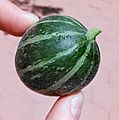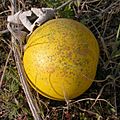Buffalo gourd facts for kids
Quick facts for kids Cucurbita foetidissima |
|
|---|---|
 |
|
| Buffalo gourds | |
| Scientific classification | |
| Kingdom: | |
| (unranked): | |
| (unranked): | |
| (unranked): | |
| Order: | |
| Family: | |
| Genus: | |
| Species: |
C. foetidissima
|
| Binomial name | |
| Cucurbita foetidissima |
|
The Buffalo gourd (Cucurbita foetidissima) is a very interesting wild plant. It has many other names like calabazilla, coyote gourd, or wild pumpkin. This plant is a small member of the Cucurbitaceae family. This is the same plant family that includes familiar foods like squash, pumpkins, and cucumbers.
Contents
What is Buffalo Gourd?
The Buffalo gourd is a type of plant that grows in dry areas. It is known for its strong smell, which is why it's sometimes called the "fetid gourd" or "stinking gourd." This smell comes from its leaves and fruits. The plant grows long vines that can spread out over the ground.
Where Does It Grow?
Buffalo gourd plants are native to North America. You can find them growing wild in the southwestern United States and parts of Mexico. They love sunny, dry places. This includes deserts, grasslands, and even disturbed areas like roadsides. They are very tough plants that can survive with little water.
What Does It Look Like?
Buffalo gourd plants have several distinct features:
- Leaves: Their leaves are large and triangular or heart-shaped. They are often covered in tiny hairs, which can make them feel rough.
- Flowers: The plant produces bright yellow or orange flowers. These flowers look a lot like squash or pumpkin blossoms. Some flowers are male and some are female, growing on the same plant.
- Fruit: The fruit of the Buffalo gourd looks like a small, round melon or a tiny pumpkin. It starts green and turns yellow or orange when it ripens. The fruit is usually about the size of a baseball. Inside, it has many seeds.
Roots of the Buffalo Gourd
One of the most amazing parts of the Buffalo gourd is its root system. It has a very large, deep taproot. This root can grow very big, sometimes weighing over 100 pounds! This huge root helps the plant store water and nutrients. It allows the Buffalo gourd to survive long periods of drought.
Uses of Buffalo Gourd
Even though the Buffalo gourd is wild and has a strong smell, it has been useful to people for a long time.
- Traditional Uses: Native American tribes traditionally used different parts of the plant. The seeds were often eaten, either roasted or ground into flour. The roots were sometimes used for soap or in traditional medicines. The gourds themselves were used as containers or rattles after they dried.
- Modern Potential: Scientists are studying the Buffalo gourd for its potential uses today. The seeds are rich in oil and protein, which could be used for food or even biofuel. The large roots contain starch, which might also be useful.
Is It Edible?
While some parts of the Buffalo gourd have been used traditionally, the raw fruit and leaves are generally not eaten. They contain bitter compounds that can be unpleasant or even harmful if consumed in large amounts. The seeds, however, are edible after proper preparation, like roasting.
Images for kids
-
Staminate (male) flower, Pomona, California
-
Buffalo gourds in Puente Hills, California
-
Immature buffalo gourd, close up photo, Albuquerque, New Mexico
-
Mature fruit, Austin, Texas
-
Mature fruit, Pomona, California
-
Interior view, Newport Beach Back Bay, California
See also
 In Spanish: Cucurbita foetidissima para niños
In Spanish: Cucurbita foetidissima para niños


















